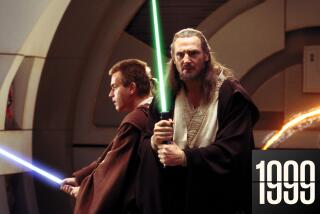Lucas Starts Animation Division
After years of fits and starts, George Lucas has quietly launched a new unit -- Lucasfilm Animation -- to help crack the lucrative digital animation business.
The “Star Wars” visionary has been frustrated by the collapse of studio-controlled animated projects that were to be produced by his organization. The new operation gives him the freedom to generate his own full-length computer-generated cartoons.
It also provides a separate identity and more autonomy to a digital animation group that had been part of Lucas’ special effects powerhouse, Industrial Light & Magic.
“Lucasfilm Animation will now have the flexibility to develop and create its own films,” said Lucas’ longtime spokeswoman Lynn Hale, who confirmed the company’s formation. “It’s extremely exciting to have the opportunity to start the search for directors to build projects around.”
Hale cautioned that the animation unit is still in its infancy and doesn’t yet have its first project lined up. Currently, the staff includes what was ILM’s nine-person animation development team, headed by Senior Vice President Patty Blau. But the creative ranks will grow, drawing talent from ILM’s pool of 1,200 effects wizards and from the animation community at large, Hale said.
The unit will no longer be constrained by scheduling demands at ILM, which creates digital effects for many of Hollywood’s biggest productions, including the upcoming releases “The Hulk,” “Peter Pan” and “Terminator 3: Rise of the Machines.”
For nearly six years, Lucas has tried -- without success -- to break into the feature animation business, which has become increasingly competitive. Rivals such as Pixar Animation Studios and partner Walt Disney Studios, DreamWorks SKG’s Pacific Data Images and 20th Century Fox’s Blue Sky Studios have cashed in on such blockbusters as “Monsters, Inc.,” “Shrek” and “Ice Age,” respectively. Last year, Sony Pictures joined the fray by forming its own computer animation outfit.
Seventeen years ago, Lucas sold Pixar -- the computer graphics division of his San Rafael-based company Lucasfilm Ltd. -- to Apple Computer Inc. co-founder Steve Jobs for $10 million. Today, as the industry leader in computer animation, Pixar has a market capitalization of $3.3 billion and has been valued at more than $4 billion by industry analysts.
Lucas and Jobs have remained close friends, and their companies often do business together. But the iconic filmmaker has been plagued by false starts when it comes to animated features of his own.
“ILM has really wanted to prove themselves in the last several years, but it’s never worked out,” said Kevin Koch, president of the Animation Guild, which represents several thousand animation professionals.
In 1997, ILM hoped to produce its first animated movie, a computer-generated “Frankenstein” for Universal Pictures. Two years later, after a regime change at the studio, however, Universal lost interest in the project and pulled the plug even though ILM’s staff had done extensive work on models and story reels.
Later, Universal -- concerned about a budget that topped $100 million -- scrapped plans to enlist ILM in making a computer-animated adaptation of the children’s classic “Curious George.” The studio and producer Imagine Entertainment now are now making a traditional, hand-drawn animated version for one-fourth the cost.
Competition and past frustrations notwithstanding, some observers believe that Lucas enjoys natural advantages that are likely to make him a serious player this time around.
“He has always been on the cutting edge of filmed entertainment technology,” said Gerard Klauer Mattison entertainment analyst Jeffrey Logsdon.
The 58-year-old Lucas, who is prepping “Star Wars: Episode III” -- the sixth and final installment of his epic series -- was unavailable for comment on the new venture.
“Episode III” is scheduled to begin shooting in Australia late next month for release in May 2005. The “Star War” movies, which Lucas owns and distributes through News Corp.’s 20th Century Fox, have taken in about $1.8 billion at the U.S. box office.
According to research firm Hoover’s Inc., privately held Lucasfilm Ltd. -- which includes movie and television production operations, ILM, Skywalker Sound, interactive games maker LucasArts and Lucas Licensing -- had revenue of about $1.5 billion in 2001.
In 2005, several of those businesses and about 2,000 employees will relocate to a new $300-million, 900,000-square-foot Digital Arts Center on a 23-acre parcel at San Francisco’s historic Presidio, a former Army base. But the filmmaker and his live-action production team, as well as the sound effects and licensing companies, will remain based at his 2,700-acre Skywalker Ranch in Marin County.
After finishing the “Star Wars” movie in the fall and serving as executive producer of the next installment of his “Indiana Jones” series, to be directed by Steven Spielberg, Lucas wants to turn to smaller, more independent films along the lines of his 1971 sci-fi movie “THX 1138,” Hale said.
More to Read
The biggest entertainment stories
Get our big stories about Hollywood, film, television, music, arts, culture and more right in your inbox as soon as they publish.
You may occasionally receive promotional content from the Los Angeles Times.










